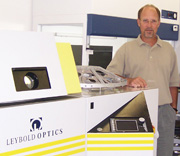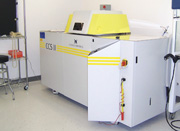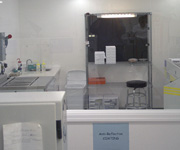KNOXVILLE, Tenn.--Volunteer Optical, a Knoxville-based lab that produces 200-300 Rx jobs per day, installed its first AR coating system about a year ago.
“We had wanted to get into AR for about five years but couldn’t afford to,” said Jeff Morgan, Volunteer’s president. “At first, we looked at sputter coaters and spin coaters because they were more in our ballpark as far as price was concerned.”
 |
| Volunteer Optical president Jeff Morgan stands in the lab’s clean room next to its Leybold CCS 250 AR unit. |
 |
| Volunteer’s clean room is set up with, left to right, an inspection station, the Leybold CCS 250 AR coater and a flow bench. |
 |
| Another view of Volunteer’s compact clean room, which measures approximately 16 feet x 16 feet. |
Morgan next looked at some higher-volume AR systems, but could not justify the half million dollar cost of a clean room with the 15 AR jobs a day he estimated the lab would process. “I knew we had to get up to 30-40 jobs a day to break even,” he said.
Another option Morgan considered but ultimately rejected was working with lens manufacturers that would apply their own proprietary AR to the front side of a lens, while Volunteer would coat only the back side.
“I didn’t want be tied down or be at mercy of the lens manufacturer,” he said.
Finally, Volunteer settled on Leybold’s CCS250 Light coating system.
“We looked at how much money we paid to an outside lab, and found that our payments on the Leybold machine would only be about $1,000 more,” said Morgan.
The lab started out doing 10 to 15 AR jobs a day. “With the flip-over system, you can run 12 pairs, and then it automatically flips them,” noted Morgan. “You can start small and grow.”
Volunteer then added a dome to increase the coater’s capacity to 180 pairs a day. With the rising number of AR jobs, Morgan decided it was time to build a clean room.
“Because of the CCS 250’s small footprint, we only needed a 16-foot by 16- foot clean room,” he explained. “We just converted our kitchen, put in air conditioning and a step-up transformer. We also had to install plumbing, plus argon and oxygen tanks and a no-dust, vacuum ceiling.”
Along with these upgrades, Volunteer uses an in-chamber ion source that enables the lab to produce a variety of coatings, including the new hydrophobic top coats. The lab produces several branded Leybold coatings, such as Jade, Brilliant and Peridot, a new super-hydrophobic. Recently, Volunteer began producing Signet Armorlite’s Kodak CleAR coating.
“Our volume has really grown in the last two weeks due to Kodak,” said Morgan. “We’re up to 40 to 50 jobs a day.” Morgan said the revenues generated from AR might be used to fund Volunteer’s next big technology investment, freeform surfacing.
“We had some disasters,” he admitted. “For example, three months down the road we found the coatings were coming off. It turned out the “freebond” material we used for blocking was contaminating the ultrasonic cleaner. The film was still on the lens when it went into the AR room, and the coating would not adhere to the lens.” The lab also had to put in a de-ionized water system, something it had not counted on doing originally.
“We learned these things the hard way, but now it’s all figured out,” said Morgan. “Based on our experience, I would advice any lab interested in getting into AR to have the vendor come in and spend a week in your lab before installing their system.”











